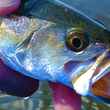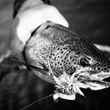“If you’re gonna kill fish, kill them fast. That’s the humane way. It’s a philosophical, common-sense approach, not based on any scientific assessment of pain.” — fisheries biologist Steve Gephard
At least twice a month I serve my family yellow-perch filets, first dredged in flour, then dipped in beaten eggs and rolled in equal portions of Italian bread crumbs and panko that’s sparsely mixed with grated parmesan cheese. I fry the filets in canola oil, squeeze on lemon juice, and add salt and pepper.
Yellow perch cooked this way gets my vote for the best-tasting of all freshwater fish. They’re the favorite meal of my smart, beautiful, kind granddaughter. But she won’t fish with me because she doesn’t like the sound of breaking perch necks or the sight of the blood that squirts from the gills.
I break the necks of perch (as well as other panfish, bass, pickerel and trout) with one quick, fluid motion, pressing heads against the boat’s gunwale or, when I’m on ice, against my knee. It takes two seconds. For bigger fish, I insert my index finger and middle finger in the gills and bend. This takes three seconds. My grandfather taught me to break the necks of fish, and my great grandfather taught him.
So here’s the question I put to my granddaughter about 12 years ago, the last time we fished together: “Which would you rather hear: The two-second crunch of broken necks or perch flapping in agony against the sides of the cooler for half an hour?”
My late angling buddy, Bill Adamonis, was a master “jiggerman.” Jiggermen are a dying breed of ice fishermen. We eschew tip-ups. Instead, we fish with handmade “jiggersticks” and handmade “jiggers” baited with perch eyeballs. When Bill and I shuffled around March “prayer ice” and heard the warble of a bluebird or the “feebee” song of a chickadee he would utter this lament: “Spring always comes so fast.”
You couldn’t tell Bill much about anything, especially fish or fishing. When I told him he needed to break the necks of perch he emphatically declared that this would impede fileting. When I walked around the ice, breaking the necks of his flapping perch he puffed and blew.
But later that day Bill learned something about fish he hadn’t known: Breaking necks makes filleting easier because it gives you a better grip on the head. More importantly, it bleeds fish (which improves their flavor); and it prevents stress, which infuses the flesh with lactic acid, cortisol and adrenaline (all of which degrade flavor and speed decay).
Most importantly, it’s the decent, humane thing to do. Leaving fish dancing to death on ground, ice, or in boat, bucket or cooler is comparable to placing humans in metal cages and submerging them until their lungs fill with water and they expire. The difference is that fish take at least ten times longer to “drown” in air.
Metal stringers are popular because anglers imagine that they keep fish fresh. Stringers do no such thing. What keeps fish fresh is killing them instantly, bleeding them, and immediately placing them on ice.
Fish commonly die on stringers, and nothing degrades fish flesh more than soaking carcasses in water, especially warm water. Fish can respire on stringers for a few hours; but this prolongs stress, thereby increasing infusion of lactic acid, cortisol and adrenaline.
What’s more, stringers are a major nuisance. They have to be kept in the water; you have to pull them every time you move your boat; and they hold only about a dozen fish. I live in Massachusetts where, as in most of Yankeeland, there’s no daily limit on panfish. (In New Hampshire, where I have a fishing camp, it’s 50 — 25 of any one species.) Panfish are so fecund that you need not feel guilty about filling a cooler. In fact, by doing so you’re apt to reduce the possibility of stunting.
Some ten years ago Dr. Brian Hiller, a wildlife professor at Bemidji (Minnesota) State University, had an epiphany about stringers. “I hadn’t really heard much about the value of bleeding fish,” he told me. “As I read more and more about the reasons to bleed fish I hung up my stringer for good. Now, if I’m keeping a fish, I bleed it right away, slice at the base of the gills to speed the loss of blood, and put it in a cooler with an ice-water slurry. No need to torture a fish by shoving a big safety pin through its mouth and dragging it behind the boat until I’m done fishing. A fast, respectful death gets the blood out of the flesh and leaves a cleaner, whiter filet that is much better tasting.”
Live wells are more humane than stringers and way more convenient. They allow high-grading (check regulations to make sure it’s legal in your state), but they still cause stress; and they facilitate illegal stocking of alien invasives by bucket biologists.
The outdoor press is rife with pieces attempting to prove that fish “don’t feel pain.” It’s all speculation and junk science intended to counter calls by the animal-rights community for a ban on recreational fishing — especially catch-and-release fishing, which it defines as torture for fun.
It would make no biological sense for any vertebrate not to feel pain (or severe “discomfort,” if one prefers). In one study, acetic acid was injected into the lips of rainbow trout, causing them to respire rapidly, delay feeding and rub their lips on gravel.
“Fish do feel pain,” Penn State University biologist Victoria Braithwaite told Hakai Magazine. “It’s likely different from what humans feel, but it is still a kind of pain.”

Hakai goes on to report: “At the anatomical level, fish have neurons known as nociceptors, which detect potential harm, such as high temperatures, intense pressure, and caustic chemicals. Fish produce the same opioids — the body’s innate painkillers — that mammals do. And their brain activity during injury is analogous to that in terrestrial vertebrates: sticking a pin into goldfish or rainbow trout, just behind their gills, stimulates nociceptors and a cascade of electrical activity that surges toward brain regions essential for conscious sensory perceptions (such as the cerebellum, tectum, and telencephalon), not just the hindbrain and brainstem, which are responsible for reflexes and impulses.”
Because the animal-rights community has it right that a fish feels at least some discomfort from a hook in its mouth or gullet, anglers can help their public image by preventing far more intense and completely unnecessary suffering caused by not killing fish quickly. This fact appears lost on most anglers with whom I converse, especially anglers on Facebook.
There's a learning opportunity on Facebook if one filters out all the food photos, ads, feel-good wildlife fairytales, introspective gushing and political bloviating. For example, photos of dead and dying fish on stringers abound on fishing sites I visit. To anyone paying attention to the posts and comments, it’s clear that stringer use varies inversely with angler experience.
On “Perch & Monster Perch” I recently offered this comment in response to a photo of nine large yellow perch hanging from a stringer: “Nice. I've found that perch taste better if you instantly break their necks and put them on ice. This bleeds them also. On a stringer they build up lactic acid and adrenaline that degrades the flesh. Also, breaking necks is more humane.”
The first response was encouraging: “Ted: I always wondered why some fishermen do that and then throw them in their cooler. Thanks for the tip. From an old timer at that.”
But then I got these:
“Your insane.”
“Breaking there neck? What neck lmao not a duck.”
“They’re fish man.”
“I live on lake Erie but never broke there Neck? Lol if I did my kids would probably throw rocks at me!!! Lmao.”
“Hope u broke there Fing necks. Good grief Ted won't stop, drinking n FB bad combo lol.”
Then in response to my patient explanations and a photo of me holding three 15-inch perch with broken necks: laughing emoticons.
I don’t know anyone with greater knowledge of fish than Steve Gephard, Connecticut’s former supervising fisheries biologist and now an environmental consultant working on fish passage. He offers this: “There has been lots of debate in the lay press about whether fish feel pain, but I’m not aware of much research going on in the technical press. By taking blood samples we can document stress, but not pain. Stress causes [flesh degrading] buildup of adrenaline and lactic acid. I fish a lot for bluefish. I kill them quickly by cutting their throats. This also bleeds them. Then I put them on ice. Regardless of what pain fish register, if you’re gonna kill fish, kill them fast. That’s the humane way. It’s a philosophical, common-sense approach, not based on any scientific assessment of pain.
“I’m not sure there’s a way of quantifying even human pain. You go to your doctor, and he asks you what’s your pain level — one through ten. That’s not scientific, but at least you have the ability to communicate. A fish doesn’t have that ability. As a scientist, I try to avoid anthropomorphizing, but when it comes to killing something, you put yourself in the position of, say, a perch, and that is: You’re gonna die. Do you want to die quickly or slowly? It’s hard to imagine a human opting for the slow way. Again, if you’re gonna kill a fish, kill it fast.”






























Comments
Bojo replied on Permalink
Great article, thank you for the thoughtful comments. I see you posted a video on 'ikejime' but is there a video link to how you have been killing your perch?
My whole life if I'm going to cook the fish I knock it hard on its head with a heavy knife, it feels like it kills it instantly. I then gut/etc back at the campsite or home. I wonder how that compares to the other methods.
Kathy replied on Permalink
I love that Ted Williams is so concerned about the welfare of our fish! I always hate hurting fish when I catch them, so I will take the barbs off the hooks and hope they do to feel any pain. I have fished with Ted and he did break the necks of the perch we caught. I was at first wondering what he was doing and then he politely told me that you would not want to let them suffer in a cooler. I loved that!!
Thank you Ted! for this amazing article.
Suzie replied on Permalink
Everyone who fishes or knows someone who does should read this article and pass it along. Why make any sentient being suffer if you can avoid it? Nice work, Ted Williams.
Edward Williams replied on Permalink
I don’t have a photo. But if you log on to the Facebook page of NANFA - North American Native Fishes Association and look for the link to this piece, you’ll see a photo I posted of me breaking a perch neck yesterday.
Peter vanstone replied on Permalink
I tried neck breaking on river trout,eight to eleven inches long sixty five year ago and shredded my finger,not bleeding,l then went back to a priest.lnstant and humane.Back then trout in large numbers,now almost gone.l do so admire American conservation,Here in Devon England,we go steadily down hill but it is excelerating
Edward Williams replied on Permalink
Hi Peter: You were probably breaking the necks of large trout. Priests work just as well. They've been used since Walton.
Ken Blanchard replied on Permalink
Hi Ted,
May I use this article for the Easthampton Rod and Gun Clubs newsletter? I will be sure to give you credit for the article.
Please advise,
Ken Blanchard Jr., ER&G Secretary
Alexandra Peters replied on Permalink
None of those methods of killing fish the author uses are approved humane methods as defined by the USA body that sets such definitions for all vertebrates (I think it's the AVMA?). Breaking the neck leaves the brain intact and in many species of fish the brain and all of the cranial nerves above the neck trauma will still work for 10’s of minutes. So you will have a fish slowing dying from lack of air and loss of blood still with an intact brain. IF you sever the spinal cord then the only ethical way to continue that kill is to pith the animal - stab its brain and scramble it so the brain doesn’t work anymore/it is brain dead.
Chad Shmukler replied on Permalink
Edward Williams replied on Permalink
Sorry, but this is nonsense. AVMA doesn’t list breaking necks as “one of its approved methods” because it has never heard of breaking fish necks. I am quite certain that you have ever broken a fish neck. Had you done so, you would understand that it’s an instant death. There is no eye, gill, fin or muscle movement. Poking around with a pin in the head of an eight-inch perch in an effort to find the brain would result in countless misses and way more pain than breaking its neck. Try doing that on a day you catch 50 or more perch.
Edward Williams replied on Permalink
Hi Alexandra: The AVMA (American Veterinarian Medical Association) hasn’t approved killing fish by breaking their necks because, like most of the public including most of the angling community, it hasn’t heard of the method. But cervical dislocation -- id est, breaking necks -- is an accepted method of euthanasia by IACUC (American Association for Laboratory Animal Science) for research purposes. As the video I attached with my piece demonstrates, stabbing the brains of big fish like striped bass works, provided it is done by an expert. Stabbing little fish like yellow perch in their BB-size brains would result in countless misses, causing unnecessary pain. What’s more, it would be completely impractical because these fish are so prolific that one would be stabbing dozens per trip.
R. Mc replied on Permalink
The imbedded youtube video is really informative. I never heard of the ikejime method before. Thanks for sharing.
Edward Williams replied on Permalink
I would't recommend the method for non-experts. Clubbing big fish on the head multiple times works just as well and is far easier.
Pages